How to Grow Runner Beans: A Comprehensive Guide for Bountiful Harvests
- March 15, 2024
- 0 comment
Discover How To Grow Runner Beans with this guide, offering tips on selecting the right spot, soil preparation, and care for these vibrant, climbing plants known for their flavorful pods. Here’s a step-by-step guide to cultivating this wonderful plant. Runner beans (Phaseolus coccineus) are annual plants known for their climbing habit. Originating in Central America, they thrive in warm, temperate climates. Unlike their cousin, the French bean, runner beans are more vigorous and produce larger pods.
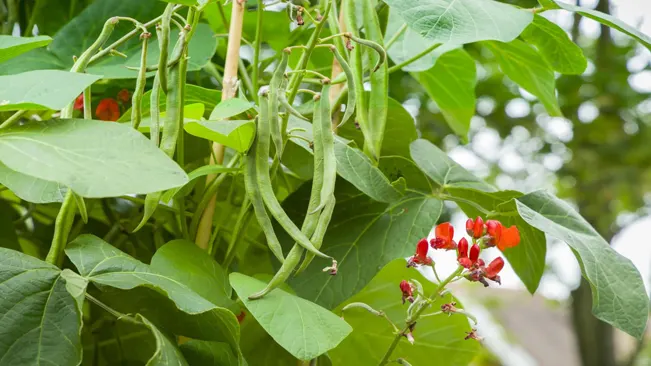
Benefits of Runner Beans
| Benefit | Description |
|---|---|
| Nutritional Value | High in protein, fiber, vitamins A, C, K, and B vitamins, and minerals like iron, magnesium, and potassium. |
| Heart Health | The fiber and antioxidants in runner beans can improve heart health by reducing cholesterol levels and blood pressure. |
| Digestive Health | High fiber content aids in digestion and helps prevent constipation. |
| Weight Management | Low in calories and high in fiber, which can help in weight management and control. |
| Blood Sugar Control | The fiber in runner beans can help regulate blood sugar levels, beneficial for people with diabetes. |
| Immune System Support | Rich in antioxidants and vitamins that can strengthen the immune system. |
| Healthy Skin and Hair | Vitamins A and C contribute to healthy skin and hair. |
| Versatility in Cooking | Can be used in a variety of dishes, ranging from salads to main courses, offering culinary diversity. |
| Easy to Grow | Suitable for home gardens; they’re easy to grow and yield a good harvest, providing a sense of accomplishment. |
| Environmental Benefit | As a legume, runner beans can fix nitrogen in the soil, improving soil fertility for future plantings. |
List on How To Grow Runner Beans
- Planting and Location
- Sowing the Seeds
- Support Structures
- Watering and Feeding
- Pollination
- Harvesting
- Common Problems
Planting and Location

When to Plant
- Frost Sensitivity: As you mentioned, runner beans are sensitive to frost. Planting them after the last frost ensures they won’t be damaged by cold temperatures.
- Specific Timing: In many temperate climates, the last frost date falls around late April to May. However, this can vary depending on your specific location. It’s important to consult a local gardening calendar or agricultural extension for precise timing.
- Germination Temperature: For optimal germination, soil temperatures should be at least 50°F (10°C). Warmer soil temperatures can lead to quicker and more reliable germination.
Choosing a Location
- Sunlight: Runner beans thrive in full sunlight. They need at least six hours of direct sunlight daily, but more is better.
- Wind Protection: While they need some exposure to the breeze for pollination, too much wind can damage the plants. A site shielded by a fence, wall, or hedge can be ideal.
- Rotation: Avoid planting runner beans in the same location where beans or peas were grown the previous year. Crop rotation helps in preventing soil-borne diseases.
Soil Preparation
- Organic Matter: Adding organic matter is key. Well-rotted manure or compost not only enriches the soil with nutrients but also improves soil structure and drainage.
- Testing Soil pH: If possible, test your soil’s pH. Runner beans prefer slightly acidic to neutral soil (pH 6.0 to 7.5). If your soil is too acidic or too alkaline, you may need to amend it.
- Soil Aeration and Depth: Loosen the soil to a good depth (about a foot) to allow the roots to grow deeply and freely. Well-aerated soil encourages healthy root development.
Sowing the Seeds

Soaking the Seeds
- Purpose: Soaking the seeds overnight in water helps to soften their hard outer shell, leading to quicker and more consistent germination.
- Method: Place the seeds in a bowl and cover them with water. It’s important to use room temperature water to avoid shocking the seeds with extreme temperatures.
- Duration: Typically, 8-12 hours of soaking is sufficient. Over-soaking can cause the seeds to rot, so avoid leaving them in water for more than 24 hours.
Sowing Depth
- Importance of Depth: Planting the seeds about two inches deep ensures they have enough soil cover to protect them from the elements and to provide stable support as they grow.
- Germination Process: At this depth, the seeds have the right balance of moisture, darkness, and warmth to germinate effectively. If planted too shallow, they may dry out or be eaten by birds; if too deep, they might not germinate properly.
Spacing
- Seed Spacing: Spacing the seeds about 6 inches apart gives each plant enough room to grow without competition for nutrients, sunlight, and water.
- Row Spacing: Keeping each row approximately 18 inches apart allows for sufficient air circulation, which is crucial in preventing fungal diseases. It also makes it easier for you to access the plants for maintenance and harvesting.
- Effect on Growth: Proper spacing results in healthier plants and a better yield. Overcrowded plants can compete for resources, leading to stunted growth and a higher likelihood of disease and pest issues.
Support Structures
Runner beans need support to grow. You can use one of the following structures:
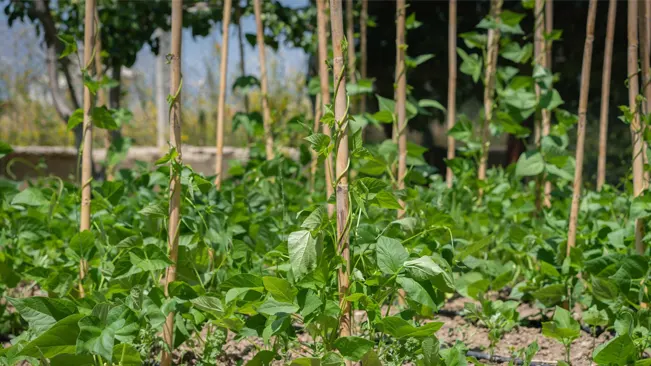
- Bamboo Canes and Wigwam Structures
- How to Set Up: To create a wigwam structure, you typically need 6-8 bamboo canes, about 6-8 feet in length. Push them into the ground in a circle, leaving about a foot between each cane at the base. Gather the tops and tie them securely, creating a cone-like structure.
- Benefits: This structure is both visually appealing and practical. It allows runner beans to climb evenly, maximizing sunlight exposure and air circulation.
- Considerations: Ensure the canes are firmly planted in the ground to support the weight of the growing plants. Also, consider the height; it should be tall enough to allow easy harvesting.
- Trellis
- Setup: A trellis can be made of wood or metal and should be secured against a wall or fence for stability. You can also find freestanding trellises.
- Benefits: Trellises are great for space-saving and can be used in smaller gardens or even on balconies. They also make harvesting easier since the beans hang down from the trellis.
- Considerations: Ensure the trellis is strong enough to hold the weight of the plants. The size of the trellis will dictate how many plants you can grow.
- Netting
- How to Use: Stretch garden netting between sturdy posts or poles. The netting should be tight and secure to support the weight of the plants.
- Benefits: Netting is a flexible and cost-effective option. It’s easy to set up and can accommodate a large number of plants.
- Considerations: Choose a netting with holes large enough to allow the beans to pass through but small enough to provide adequate support. Regularly check the tension of the netting.
Watering and Feeding
Watering Runner Beans
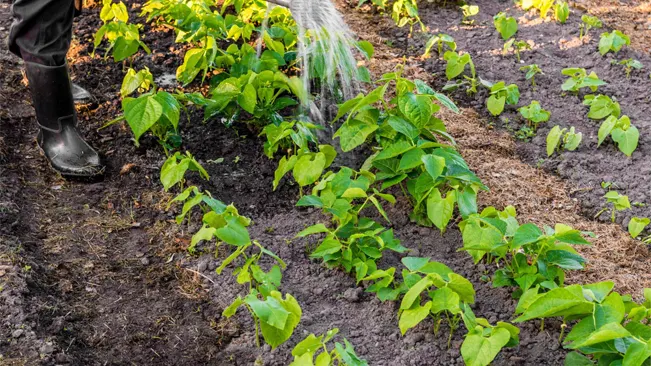
- Consistency is Key: Runner beans thrive in soil that is consistently moist. This means regular watering, especially during dry spells. However, it’s crucial to avoid overwatering, as this can lead to waterlogged soil, which can cause root rot.
- How Much to Water: The amount of water your runner beans need depends on the weather and soil type. In general, aim for about an inch of water per week, either from rainfall or manual watering. In hot, dry conditions, they may need more.
- Best Time to Water: Early morning or late evening is the best time to water plants, as it reduces evaporation and allows water to seep deeply into the soil.
- Watering Technique: Use a soaker hose or drip irrigation for deep watering. This method helps deliver water directly to the roots and keeps the foliage dry, reducing the risk of disease.
- Monitoring Soil Moisture: Check the soil moisture regularly. The soil should be moist but not soggy. You can check this by pushing a finger an inch into the soil. If it feels dry at your fingertip, it’s time to water.
Feeding Runner Beans
- Importance of Potassium: Once the first flowers appear, feeding your runner beans with a potassium-rich fertilizer is beneficial. Potassium helps in fruit formation and improves the overall health of the plant.
- Type of Fertilizer: A general-purpose vegetable fertilizer or one specifically designed for tomatoes (which are also high in potassium) is ideal. Ensure it’s more potassium-heavy (look for a higher ‘K’ value in the NPK ratio on the fertilizer package).
- Frequency of Feeding: Apply the fertilizer according to the product’s instructions, usually every two weeks. Over-fertilizing can harm the plants, so it’s important to follow the recommended amounts.
- Avoiding High Nitrogen Fertilizers: High nitrogen fertilizers can lead to lush foliage but fewer beans. Therefore, once the plant starts flowering, focus on potassium rather than nitrogen.
- Organic Alternatives: If you prefer organic methods, consider using comfrey tea or a seaweed-based fertilizer. These natural options are also rich in potassium.
Pollination
Runner beans are usually pollinated by bees. If you’re growing them in a greenhouse, you might need to hand-pollinate.
Bee Pollination
Runner beans are predominantly pollinated by bees, which play a crucial role in their growth cycle. Here’s how it works:
- Attraction: The bright flowers of runner beans are designed to attract bees. These flowers, typically red or white, are not just for show; they serve as beacons for bees.
- Transfer of Pollen: As bees move from flower to flower collecting nectar, they inadvertently transfer pollen. When a bee lands on a flower, the pollen sticks to its body. As the bee moves to the next flower, some of this pollen rubs off, leading to fertilization.
- Fertilization and Fruit Development: Once the flower is pollinated, it can develop into a pod, which is the part of the runner bean we commonly eat.
Hand Pollination
In some situations, like in a greenhouse or an area with a low bee population, natural pollination might not be sufficient. In such cases, hand-pollination can be an effective alternative. Here’s how to hand-pollinate runner beans:
- Identify the Flowers: Runner bean plants have both male and female parts within the same flower, making them self-fertile.
- Tools: You can use a small paintbrush or even your finger to transfer pollen.
- Technique: Gently brush the inside of a flower with your tool to collect pollen, then transfer this pollen to another flower. The goal is to mimic the action of bees as closely as possible.
- Timing: The best time for hand-pollination is mid-morning when the flowers are fully open, and the pollen is more likely to be viable.
Harvesting
Runner beans are best harvested when they are about 6 to 8 inches long. At this stage, the pods are tender and the seeds inside have not fully developed, ensuring a softer texture and a more pleasant taste. If left on the plant too long, the pods can become tough, stringy, and less flavorful.
Timing and Frequency
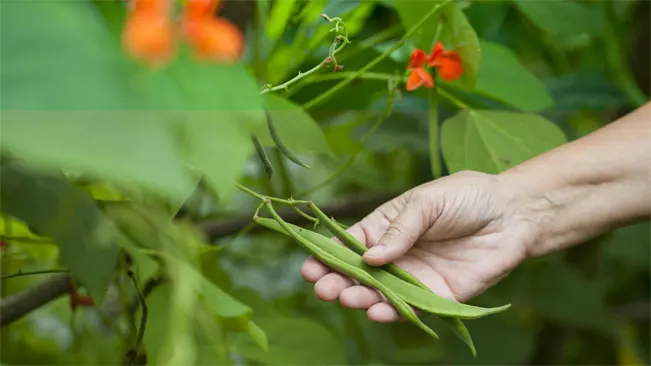
- Early and Regular Harvesting: Begin harvesting as soon as the beans reach the appropriate size. Regular picking is crucial as it stimulates the plant to produce more flowers and, subsequently, more pods. If beans are left on the plant to mature, it signals the plant that its reproductive phase is successful, reducing the yield of new pods.
- Daily Checks: During the peak of the season, it’s a good idea to check your plants every day or two, as runner beans can grow quickly.
- Gentle Picking: When harvesting, be gentle to avoid damaging the plant. Hold the stem with one hand and the pod with the other, gently twisting the pod off. Alternatively, use a pair of scissors or pruning shears to cut the pods from the plant.
Post-Harvest Tips

- Storage: If you’re not using the beans immediately, they can be stored in the refrigerator for about a week. Ensure they are dry before storing to prevent mold.
- Preservation: Runner beans can also be blanched and frozen for long-term storage. This is a great way to enjoy your harvest throughout the year.
- Seed Saving: If you wish to save seeds for next season, allow some pods to mature fully on the plant. These pods will be larger, more fibrous, and the beans inside will be fully developed. Harvest these pods when they have dried on the plant, and store the seeds in a cool, dry place.
Signs of Over-Mature Pods
- Appearance: Over-mature pods may appear swollen as the seeds inside grow larger. The pod color might also change or become dull.
- Texture: They become fibrous and tough, which makes them less desirable for culinary uses.
Common Problems
Pests
- Slugs and Snails:
- Description: These are common garden pests that feed on the leaves and stems of young plants, especially in wet conditions.
- Prevention/Control: Regularly check plants, especially in the evening. Use organic slug pellets, copper tape, or barriers like eggshells or coffee grounds. Encourage natural predators like birds and hedgehogs.
- Aphids:
- Description: Small, sap-sucking insects that can be green, black, or white. They often cluster on new growth or under leaves.
- Prevention/Control: Introduce beneficial insects like ladybirds or lacewings. Use insecticidal soap or neem oil. Encourage healthy plant growth to withstand damage.
Diseases
- Mosaic Virus:
- Description: A viral disease characterized by mottled or distorted leaves. It stunts growth and reduces yields.
- Prevention/Control: There’s no cure for plants infected with mosaic virus. The best approach is prevention by using virus-free seeds, controlling aphids (which can spread the virus), and removing infected plants immediately.
- Bean Rust:
- Description: A fungal disease that causes powdery or rusty spots on leaves. It can weaken plants and reduce yields.
- Prevention/Control: Ensure good air circulation by spacing plants correctly. Avoid overhead watering to keep leaves dry. Fungicides can be used, though often not necessary if conditions are not overly damp.
Flower Drop
- Causes:
- Too Much Nitrogen: Excess nitrogen encourages leafy growth at the expense of flowers and pods.
- Dry Conditions: Runner beans need consistently moist soil. Dry soil can stress plants, leading to flower drop.
- Prevention/Control:
- Soil Balance: Use a balanced fertilizer; avoid high-nitrogen formulas.
- Consistent Watering: Keep the soil evenly moist, especially during flowering and pod formation.
Related Post:
- How to Grow Jicama: Your Easy Guide to Cultivating the Mexican Yam Bean
- How to Grow Cinnamon Basil: A Beginner’s Guide to Aromatic Gardening
- How to Grow Roma Tomatoes: Expert Tips for a Lush Homegrown Harvest
- How to Grow Blackberries: Easy Steps to Grow and Nurture Your Own
Conclusion
Runner beans, with their cascading red or white blooms, are a visually stunning addition to any garden. They provide a nutritious and versatile crop, packed with essential vitamins, minerals, and fiber. The ease of growing them, coupled with their ability to enrich the soil with nitrogen, makes them an ideal choice for sustainable gardening. Moreover, their adaptability in various recipes, from salads to main dishes, allows for creative culinary explorations.
FAQs (Frequently Asked Questions)
- What is the best time to plant runner beans?
The best time to plant runner beans is after the last frost in spring, as they are sensitive to cold temperatures. - How much sunlight do runner beans need?
Runner beans need full sunlight, ideally around 6-8 hours of direct sunlight per day. - What type of soil is best for runner beans?
They thrive in well-draining soil enriched with organic matter, with a pH between 6.0 and 7.5. - How should I space my runner bean plants?
Plant runner bean seeds about 6 inches apart, with rows spaced 18 inches apart. - Do I need to support runner bean plants?
Yes, runner beans are climbing plants and require support such as bamboo canes, trellises, or garden netting. - How often should I water runner beans?
Water them regularly to keep the soil consistently moist, especially during dry periods and when the beans are forming. - Do runner beans need a lot of fertilizer?
They don’t require a lot of fertilizer. Feeding them with a potassium-rich fertilizer once flowering begins is sufficient. - How do I protect runner beans from pests?
Regularly inspect plants for pests like aphids, slugs, and snails, and remove them manually or use organic pest control methods. - When are runner beans ready to harvest?
Harvest them when the pods are about 6 to 8 inches long but before they become too swollen or tough. - Can I save seeds from my runner beans for next year?
Yes, you can save seeds from mature pods at the end of the season. Dry them thoroughly before storing in a cool, dry place.

Kristine Moore
Forestry AuthorI'm Kristine Moore, a seasoned garden landscaping professional with over 30 years of experience. My extensive career has been dedicated to transforming outdoor spaces into stunning, sustainable landscapes. With a deep understanding of horticulture, design principles, and environmental stewardship, I have become a respected figure in the field, known for creating harmonious, visually appealing, and eco-friendly gardens. My commitment to excellence and continuous learning in landscaping trends and techniques has solidified my reputation as an expert in garden design and implementation.


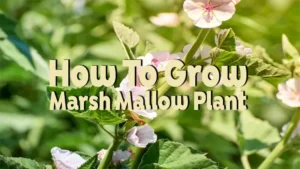
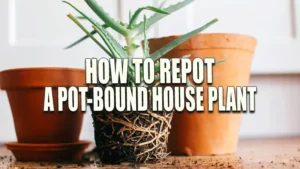




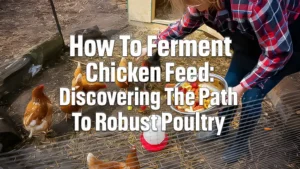
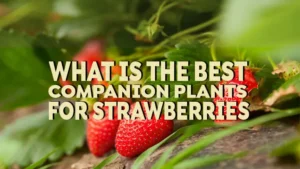
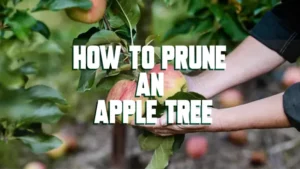


Leave your comment